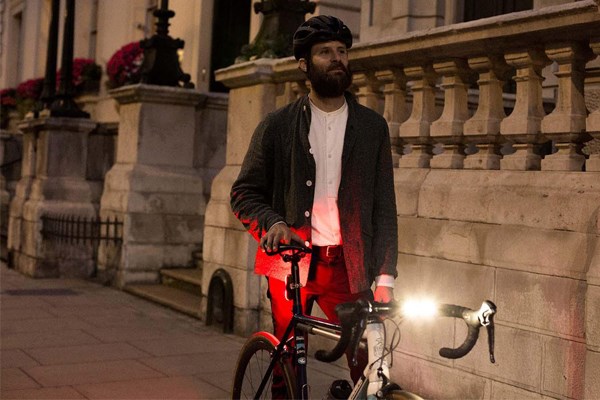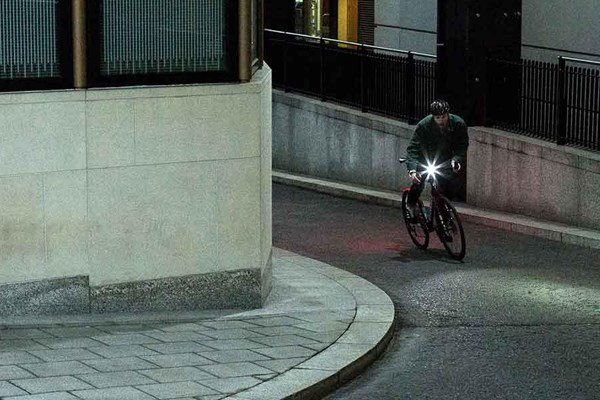As the calendar turns to September and summer slides away, us cyclists need to strap lights on to keep riding.
Bike lights are a necessity if you’re going to ride through to spring, but what should you look for when buying some? If you’re riding on public roads, what are the legalities on bicycle lights? We’ve taken some frequently asked questions about bike lights and given you a concise answer to each.
Before you get stuck in, our introductory bike lights guide might be useful. The same goes for our choosing a front light piece and our top tips for cycling at night article.
What is the current UK legislation on bicycle lights?
Riding a bike on a public highway in England, Wales, Scotland and Northern Ireland is covered by the Road Vehicles Lighting Regulation (RVLR). First published in 1989, but with many major revisions since then, here’s a summary.
From sunrise to sunset and a cyclist is required to have…
- A front light, which emits a white light, positioned up to 150cm from the ground.
- A rear light, which emits a red light, positioned between 35cm and 150cm from the ground.
- A red, rear reflector positioned between 23cm and 90cm from the ground.
- An amber reflector on each pedal, positioned so that one is visible to the front and rear of the bike.
- Of course, the above is the minimum requirement and choosing to exceed those would be a sensible thing to do.

Is there a maximum output for a light in use on public roads?
No. But much like car lights on full beam, you don’t want to dazzle other road users with your lights. Most front lights these days have multiple modes, allowing you to cycle through various strengths, helpful if you’re planning to ride through different lighting conditions.
Can I ride with only flashing lights?
In a word, yes. Flashing lights, front and rear, meet the legal requirement if they flash between 60 and 240 times a minute and emit at least four candelas (a measure of luminous intensity exceeded by most lights today).
Scientific studies have attempted to understand the impact of flashing or constant light and its impact on cyclists’ visibility to other road users. Investigations centred on front lights concluded that there was no significant difference between flashing and always-on when compared to the distances that drivers recognized cyclists using each light mode.
A rear light study, however, did find that a flashing rear light can make cyclists more visible to drivers, relative to a solid red light. Findings from the same study concluded that a light on the pedals, or feet of the rider, was the most effective in grabbing a motorist’s attention.
In our experience, it doesn’t hurt to have one light flashing and one constant, at the front and rear. Flashing lights are more eye-catching, while the steady light helps people judge how far away you are. Some models, like Exposure bike lights, are capable of emitting flashing and constant light at the same time, covering both bases in one compact package.
What does LED mean?
LED stands for Light Emitting Diode. Think of your traditional incandescent household bulb with a filament and compare it to modern-day spotlights. These days, LEDs are ubiquitous across all bike lights.
What are lumens?
You’ll see that a bike light’s output is measured in lumens – this a unit of strength and is useful when comparing one light to another. As a guide, your smartphone’s torch is around 50 lumens, 450 lumens are roughly equivalent to the light emitted from a traditional 40w bulb and a car’s headlight produces 700 lumens.
As a rough estimate, if you’re riding on unlit roads, we’d recommend a front light of 800 lumens or more, and if you’re heading off-road, 1000 lumens is what we’d suggest. Of course, lights with more lumens tend to be more expensive, so factor this in when deciding which light to purchase.
Lumens aren’t everything, however. Designers play with a light’s beam pattern to help its suitability for different styles of riding. More on this later.
Where should I place my lights on my bike?
This will vary depending on the bike you’re riding, but as a general guide, your bike’s seatpost is the perfect spot for a rear and the middle of your handlebars is where you should be putting your front light.
Saddlebags, backpacks, pannier bags and pannier racks often have loops for attaching rear lights, perfect if you’re searching for somewhere to put a secondary flasher.

Should I ride with a light on my helmet?
Your helmet or rucksack are great places to fit an extra little light at a different level to the others. This is especially useful if you’re riding in traffic and want to be seen over cars in the dark. A front-mounted helmet has the added benefit of pointing the same way you’re looking. Perfect for when you’re approaching a junction, or if you’ve spotted something rustling in the hedge next to you!
These days, some helmets even have integrated rear lights for extra visibility.

Should I ride with lights during the day?
Since 2011 all cars sold in the UK have had daytime running lights (DRL) fitted to reduce road fatalities and collisions. Evidence suggests that DRL on cars can reduce incidences during daylight hours by up to 6%, but what about cycling?
Research by road safety body ROSPA concluded that 80% of all cycling accidents occur during daylight hours, so why aren’t we all riding with lights during the day? SeeSense think we should, alongside other manufacturers they design daytime specific bike lights. The company from Northern Ireland believes that “daylight-visible bike lights are brighter and stronger than those just created for night-time use. As a result, drivers have more time to see you, react and give you space on the road.”

I’ve seen some brands talk about different lights for different cycling disciplines. What’s the story there?
The different demands of road and off-road riding are such that you’ll find some lights marketed at different riding disciplines. Road lights, where speeds are faster, are designed to throw out a wide, flat beam lighting up your periphery as you ride, as well as a spot beam to light the immediate road ahead. Bike lights designed for mountain biking are extremely powerful beasts. Upwards of 1000 lumens, they help you spot hazards like overhanging branches, as well as enabling you to spot braking and turning points.

How much should I spend?
Ultimately the best lights for you will depend on several factors, including price. Our recommendation? Think about the environment your night ride is going to take place in and how long it’s going to last – this should start to narrow down your options. A ballpark figure? Budget £80 for a set of lights to see, and around £20 for a set of lights to be seen.
Should I buy rechargeable lights?
Nowadays, most lights are rechargeable, and most use a standard USB interface too! If you’re riding to work, that means it’s easy to plug them into your computer or the wall during the day. They’re the most environmentally friendly option too.
How long do bike lights take to charge?
This can vary from light to light but expect to wait around 5 hours to get a powerful front light back to full juice if you’ve run it out of battery. If the information is available, we’ll always list a recharge time for each bike light on our website.
What about dynamo lights or integrated lights?
Dynamo lights are powered by an energy generating wheel hub. As such, they can be prohibitively expensive if your bike doesn’t have a dynamo hub. On the flip side, they’re extremely reliable, convenient and environmentally friendly.
Electric bikes, especially electric urban bikes, are often sold with integrated lights. Utilising the power from their onboard battery, they’re there when you need them and don’t need charging!
